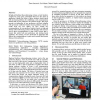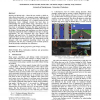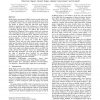GRAPHICSINTERFACE
2011
13 years 7 months ago
2011
In traditional graphical user interfaces, the majority of UI elements are hidden to the user in the default view. Application designers and users desire more space for their appli...
GRAPHICSINTERFACE
2011
13 years 7 months ago
2011
In high-end desktop videoconferencing systems, several windows compete for screen space, particularly when users also share an application. Ideally, the layout of these windows sh...
GRAPHICSINTERFACE
2011
13 years 7 months ago
2011
We present the design and experimental evaluation of pop-up depth views, a novel interaction technique for aiding in the placement or positioning of a 3D cursor or object. Previou...
GRAPHICSINTERFACE
2011
13 years 7 months ago
2011
The classic task of image compositing is complicated by the fact that the source and target images need to be carefully aligned and adjusted. Otherwise, it is not possible to achi...
GRAPHICSINTERFACE
2011
13 years 7 months ago
2011
Steering and driving tasks – where the user controls a vehicle or other object along a path – are common in many simulations and games. Racing video games have provided users ...
GRAPHICSINTERFACE
2011
13 years 7 months ago
2011
In this paper we introduce the notion that artists should be able to control fluid simulations by providing examples of expected local fluid behavior (for instance, an artist mi...
GRAPHICSINTERFACE
2011
13 years 7 months ago
2011
People generally remember locations in visual spaces with respect to spatial features and landmarks. Geographical maps provide many spatial features and hence are easy to remember...
119
click to vote
GRAPHICSINTERFACE
2011
13 years 7 months ago
2011
Most of existing crowd simulation algorithms focus on the moving trajectories of individual agents, while collective group formations are often roughly learned from video examples...
GRAPHICSINTERFACE
2011
13 years 7 months ago
2011
Multi-display environments (MDEs) connect several displays into a single digital workspace. One of the main problems to be solved in an MDE’s design is how to enable movement of...



